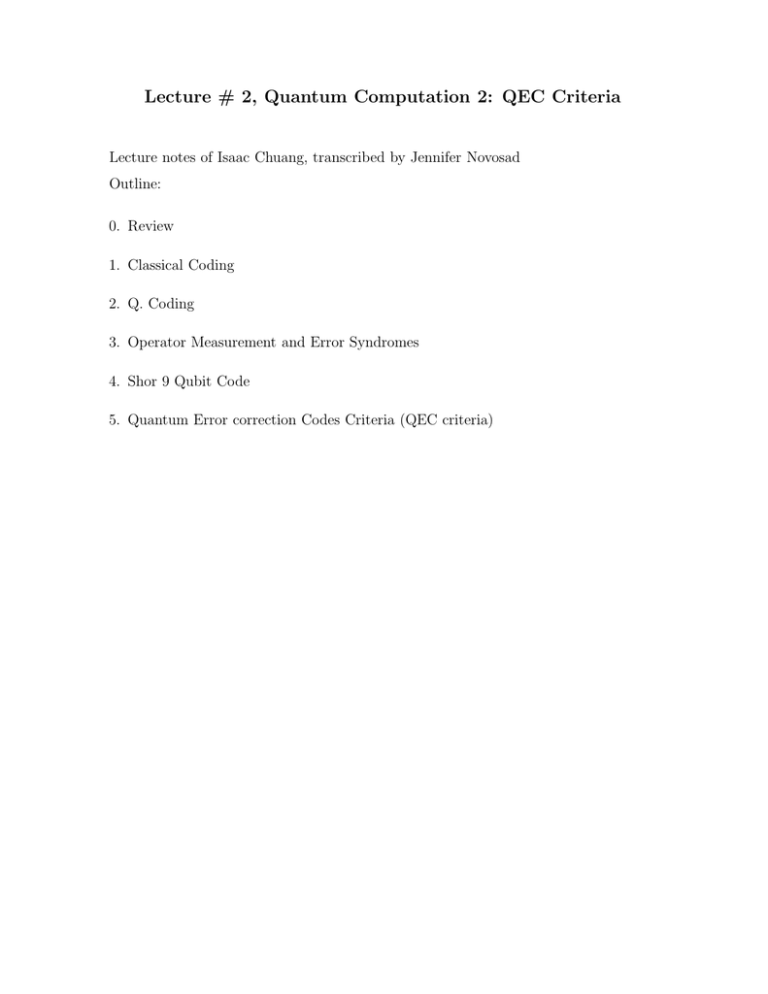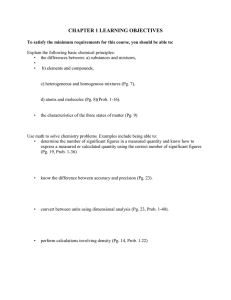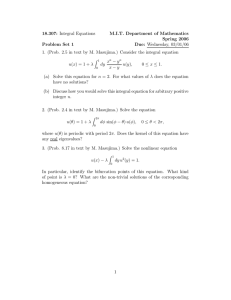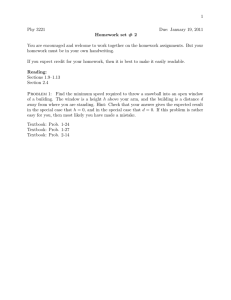Lecture # 2, Quantum Computation ...
advertisement

Lecture # 2, Quantum Computation 2: QEC Criteria
Lecture notes of Isaac Chuang, transcribed by Jennifer Novosad
Outline:
0. Review
1. Classical Coding
2. Q. Coding
3. Operator Measurement and Error Syndromes
4. Shor 9 Qubit Code
5. Quantum Error correction Codes Criteria (QEC criteria)
2
0. Review
�
χ ≡ χ∗
β(χ) =
�
k
Ek χEk† where
�
k
Ek Ek† = I
3
1.
CLASSICAL CODING
1-p
0
0
p
p
1
1-p
1
FIG. 1: a binary symmetric channel
P = prob of error
Definition: A Classical [n,k,d] code is a set of 2k n-bit strings which have a minimum
Hamming distance d.
Definition: A Hamming distance between two bit strings is d(x, y) = w(x ∃ y) where ∃
is the x-or operator, and w is an operation that counts the number of ones.
Example: 0L(ogical) = 000, 1L = 111 is a [3,1,3] code
could send
could receive
prob
decode
0L = 000
000
(1 − p)3
0
001
p(1 − p)2
0
010
p(1 − p)2
0
100
p(1 − p)2
0
011
p2 (1 − p)
1
p2 (1 − p)+
101
p2 (1 − p)
1
p2 (1 − p)+
110
p2 (1 − p)
1
p2 (1 − p)+
111
p3
1
p3
So, the total probability of error is 3p2 − 2p3 = O(p2 )
prob. of error
4
2.
QUANTUM CODING
1995: Thought error correction to be impossible!
1. States collapse on measurement
2. Classically error occurs or does not occur. In Q. M., errors are continuous: �|0→ +
�|1→ ≡ (� + β)|0→ + ...
3. No cloning Thm prohibits copying, so cannot create �|0→ + �|1→ ≡ (�|0→ + � |1→)(�|0→ +
� |1→)(�|0→ + � |1→)
The Solutions:
1. Measure only the effect of the environment, not the state (i.e. did an error occur?)
2. & 3. Orthogonalize errors using entanglement: the environment has done one thing, or
another, in an entangled way. �|didsomething→ + � |didnothing→
Example: The Quantum Bit Flip Code:
|0L → = |000
→
|1L → = |111→
|�L → = �|0L → + � |1L →
suppose β(χ) = (1 − P )χ + P XχX where P is the probability of error and X is the error
operator.
�(�)
A≡ B
Define: An [[n,k]] quantum code C is a k-qubit subspace of an n-qubit Hilbert space. So,
for our example, k=3, n=1.
5
��3
Input
|�� = �|000� + � |111�
3.
� Output
prob
decode
prob. of error
�|000� + � |111�
(1 − p) 3
0
�|001� + � |110�
p(1 − p)2
0
�|010� + � |101�
p(1 − p)2
0
�|100� + � |011�
p(1 − p)2
0
�|011� + � |100�
p2 (1 − p)
1
p2 (1 − p)+
�|101� + � |010�
p2 (1 − p)
1
p2 (1 − p)+
�|110� + � |001�
p2 (1 − p)
1
p2 (1 − p)+
�|111� + � |000�
p3
1
p3
OPERATOR MEASUREMENT
Given U with eigenvalues ±1, eigenvectors |u± →
Definition: Measuring U
H
H
0
C0 u+
U
measurement result
z
�
C1 u-
Initially, the state is |0→(C0 |u+ → + C1 |u− →)
�1 (|0→ + |1→)(C0 |u+ → + C1 |u− →)
2
Controlled-U gate, �12 (|0→(C0 |u+→ + C1 |u− →) + |1→(C0 |u+ → − C1 |u− →))
last Hadamard, �12 (|0→ + |1→)(C0 |u+ → + C1 |u− →) + (|0→ − |1→)(C0 |u+ → −
After the first Hadamard,
After the
After the
= |0→C0 |u+ → + |1→C1 |u− →
If the measurement is z = 0, then |P si→ = |u+→. (With prob C02 , z = 0)
If the measurement is z = 1, then |P si→ = |u− →. (With prob C12 , z = 1)
3.1.
U1 = δz1 δz2 = δz δz I
U2 = δz2 δz3 = Iδz δz
Error Correction Syndrome Measurement
C1 |u− →)
6
state
U1
U2
�|000� + � |111�
0
0
�|001� + � |110�
0
1
�|010� + � |101�
1
1
�|100� + � |011�
1
0
TABLE I: 0 represents a +1 eigenstate of U i , and 1 represents a -1 eigenstate.
Steps to Error Correction:
1. measure syndrome operators (here, U1 & U2
2. Apply recovery operator R (here, 00 ≡ I, 01 ≡ δx3 , 11 ≡ δx2 , 10 ≡ δx1
To create the initial state |P siL →:
� 0
+� 1
� 000
0
+ � 111
0
And then to error correct:
0
�
H
H
αz
Ψ
αz
R
αz
αz
0
H
H
note: the double lines indicate classical information.
7
Claim:
This scheme also corrects for a small continuous rotation error!
We will do this on one bit to demonstrate.
β(χ) = eiεδx χeiεδx
e−εδx = Rx (2ε)
Rx1 (2ε)|�→ ∝
= |�→ − iεδx1 |P si→ ∈ |�∗ →
The fidelity is F = |√�|�∗ →|2 ∝
= 1−ε
Syndrome measurement collapses error into either I or δx1
F (R(β(χ)), |�→) ∝
=? ∝
= 1 − ε2
Example: The Phase Flip Code
βphasef lip(χ) = (1 − P )χ + P δz χδz
Recall Hδx H = δz , Hδz H = δx
So, Hβphasef lip(HχH)H = βbitf lip
Explicitly,
� 0
+� 1
H
0
H
0
H
0L = |+++
1L = | - - ­
Ψ
H
H
R
H
+
= 0 + 1 / sqrt(2)
_
= 0 - 1 / sqrt(2)
For the bit flip: Uo = δz δz I and U1 = Iδz δz
For the phase flip: Uo = δx δx I and U1 = Iδx δx
Claim:
arbitrary errors can be described as δx , δz , and δx δz errors
Proof Argument:
�
β(χ) = k Ek χEk†
where we are guaranteed
�
k
Ek Ek† = I
Recall pauli matrices δj = I, δx , δy , δz , and that δy = −iδx δz
�
Since δj is a basis for all 2x2 hermitian matrices, let Ek = j Ckj δj .
8
�
Then, β(χ) = kjj � Ckj Ck�j � δj χδj �
�
β(χ) jj � �jj � δj χδj �
is the “Chi representation or OSR”
Example: recall
∝ |P si→ − iεδx |P si
→
Rx (2ε)|�→ =
β(χ) = χ − iεδx χ − iεχδx + ε2 δx χδx
The −iεδx χ − iεχδx term disappears in the syndrome measurement, and the χ + ε2 δx χδx
term remains.
The result is that the syndrome measurement projects the environment into a definite
error state.
9
4.
SHOR 9 QUBIT CODE
⊕
|0L → = (|000→ + |111→)�3 / 8
⊕
|1L → = (|000→ − |111→)�3 / 8
this code will correct ANY single qubit error.
Syndrome Measurements:
for a bit flip: δz1 δz2 , δz2 δz3 , δz4 δz5 , δz5 δz6 , δz7 δz8 , δz8 δz9
for a phase flip: δx1 δx2 , δx3 δx4 , δx4 δx5 , δx5 δx6 , δx6 δx7 , δx8 δx9 ,
10
5.
Channel: E(χ) =
�
k
QEC CRITERIA/CONDITIONS
Ek χEk†
Thm: Let C be a quantum Code defined by the orthonormal states { |�l → }
� a quantum recovery operation R correction β on C iff:
1. Orthogonality:
if I have 2 errors j and k,
√�l |Ej† Ek |
�l → = 0
2. Nondeformation criteria:
√�l |Ek† Ek |�l → = dk �l
this is so you cannot distinguish shrinking on different code words, all shrinking is the
same.
C
Ψ
C
C
C
No Overlap or Unique Deformations
C
C
C
note that dk implies probability loss, but not information loss,
�
†
k Ek Ek
=1
�
k
dk = 1 since
Proof: (≡)
�
Let P = l |�l →√�l | (project onto C)
note P Ej† Ek P = dk αjk P (*)
note by Polar decomposition (extracting rotation and shrinkage) Ek P = Uk
⊕
⊕
dk Uk P where dk is the shrinkage and Uk P is the rotation.
1. Syndrome measurement:
�
P Ek† Ek P =
11
let Pk = Uk P Uk† =
Ek P Uk†
�
dk
=
Uk P Ek†
�
dk
By (*), the Pk s are orthogonal:
�k ∼= j, Pk Pj ∀ Uk P Ek† Ej P Uj† = 0
measure Pk output k syndrome.
2. Apply Recovery R
�
R(χ) = k Uk† Pk χPk Uk
note for |�→ � C ,
Uk† Pk Ej |�→ =
Uk† Uk P Ek†
�
Ej P |�→
dk
=
�jk dk P
�
|�→
dk
=
⊕
dk αjk |�→
Thus:
R(β(|�→√�|) = R(
�
j
Ej |�→√�|EjT ) =
�
jk
Uk† Pk Ej† Pk Uk =
�
jk
dk αjk P = |�→√�|







